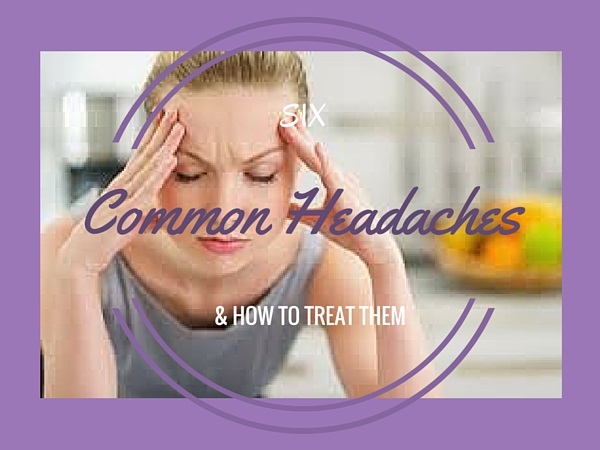Here are six common headache types and how you can treat them.
1. Caffeine headaches
If, like me, you love your coffee and find yourself drinking considerably more than you should throughout the day, your brain actually gets used to that daily dose of caffeine. Then, if you don’t get your usual quota for the day, your brain actually goes into withdrawal, which results in a really bad caffeine headache.
There are two ways you can handle this. You either have to make sure you drink your usual amount of coffee at the same time (which may mean you are consuming way more than is good for your body), or wean yourself off it entirely. However, be sure you do not abruptly stop use of the caffeine or else you will find yourself with one awful caffeine withdrawal headache, which could trigger a migraine.
2. Cluster headaches
This type of headache generally occurs on one side of the head. It is sometimes accompanied by redness in the eyes and tears. They can last anywhere from 15 minutes to several hours and can be so severe, they have been referred to as “suicidal headaches” due to their intensity. These types of headaches can be caused by cigarettes, alcohol or even high altitudes, and in some cases, foods high in nitrates — such as bacon and other meat with preservatives.
This type of headache is not so easy to eliminate. I have a specific oil I use which is great for headaches in my experience. (For more information, contact me through my Website or email.) You can even try rubbing some type of analgesic cream on the back of your neck (I have a really excellent one, which again you can contact me about). Try avoiding the alcohol and cigarettes for prevention. Drink plenty of water and try to get some rest. Putting a cold compress on the eyes and back of the neck can really help.
3. Menstrual headache
Women experience a drop in estrogen levels before starting their period, which causes what we commonly refer to as PMS. Headaches are a common symptom of PMS, and you will find that you experience them about three days prior to menstruation and two days following.
These headaches are not so serious as other types of headaches and can easily be treated with over-the-counter medications. However, if like me you are not into the pill-taking to eliminate problems, you can try staying very hydrated for four to five days prior to your menstrual cycle and keep hydrated throughout the cycle. You can also try meditation, yoga, relaxation and deep breathing exercises to help.
4. Tension headaches
This is one of the most common headaches, and I’m sure it’s no surprise that it is generally caused by stress. However, it could also be caused by bad posture or even clenching your jaw. A tension headache entails a throbbing sensation as well as constant, aching pressure on the sides of the head or in the neck as well as at the back of the head. If you’ve experienced this type of headache, I’m sure you know that if left untreated, it only gets worse.
To treat this type of headache, you can always pop a pill (like acetaminophen or ibuprofen), but being an holistic health coach, my first go-to would be more natural remedies. I have a specific oil I use which has helped me with tension headaches in alleviating some of the symptoms. (Again, for more information, contact me through my Website or email.) You can also learn stress management or relaxation techniques which can help alleviate the stress. Also watch your posture. You can also try some deep breathing exercises, and make sure you are breathing well throughout the day.
5. Migraine headache
Migraine is considered to be the most severe type of headache (as if migraine sufferers didn’t already know that!!). Migraines are three times more likely to occur in women than men, and although the exact cause of migraine is not known, migraines are thought to be caused by triggers such as skipping meals, lack of sleep, too much sleep, hormonal imbalances, foods, and many more.
Migraines can, as you know, be treated with drugs, but the most effective and natural ways I have found in my own life, include regular eating, and good, healthy non-processed foods, a regular sleeping schedule, regular exercise, cutting down or stopping caffeine, and avoiding certain smells, loud noises and bright lights. I also include oils in my routine as well as stretching exercises, relaxation and meditative practices.
6. Weekend headache
Do you ever find yourself so looking forward to the weekend only to have it thwarted by ending up with a horrible headache or migraine? This happens way too often in some people’s lives. These are even more common with people who have experienced a very stressful week and are more likely to occur with lack of sleep on the weekends or even irregular sleep during the week.
The best way to attack this type of headache is to make sure that you stick to a regular, healthy sleep schedule throughout the week, and on a Friday night, be mindful that staying up those extra few hours could trigger a bad headache the next day. Weigh the pros and cons as to whether, in the long-run, it’s worth it or not.
With any type of headache or migraine, it is always best to live a consistent lifestyle and avoid your triggers. Be sure to get regular and sufficient sleep, and avoid stress as much as possible. Learn some relaxation techniques and breathing exercises that will help you combat your stress and help you deal with the pressures of your own life.

